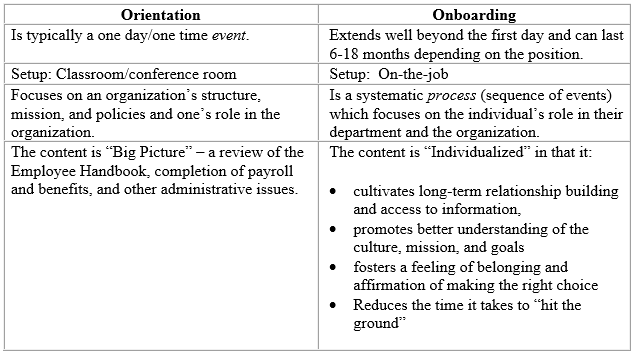 I recently did a morning seminar for the Thumb Area Manufacturing Forum on the “Three Keys to Hiring, Developing, & Retaining Top Performing Employees”. The first key, as you might guess, was to improve their hiring process. But, given the time I had to do the seminar, I wasn’t able to expand on all facets of the hiring and retention process. WHAT DID I MISS? The importance of onboarding – and that’s the topic of this newsletter.
I recently did a morning seminar for the Thumb Area Manufacturing Forum on the “Three Keys to Hiring, Developing, & Retaining Top Performing Employees”. The first key, as you might guess, was to improve their hiring process. But, given the time I had to do the seminar, I wasn’t able to expand on all facets of the hiring and retention process. WHAT DID I MISS? The importance of onboarding – and that’s the topic of this newsletter.
Unfortunately, too many organizations today still adhere to the “sink or swim” approach of onboarding. Sure, they’ll conduct an orientation session with new hires where everyone will sign all the necessary paperwork, get their employee badge and handbook, be shown the location of the restrooms, spend an hour or so watching a company policy video, be told when and where to report on their first day, and take a tour of the facility. Then the fun begins …
Your new employee shows up on the first day of work and, if they work in the office, they often times weren’t told the location of their cubical or office. When they do find it, no one has cleaned out the last person’s mess, their assigned laptop hasn’t been delivered (nor have their business cards and name plate), their phone is disconnected, their welcome meeting was cancelled by their hiring manager (too busy), and they didn’t get the invitation to their first after-work activity with the rest of the team.
If your new employee works on the shop floor, it’s pretty much the same. Their new boss has a line or a machine down and either tells someone to show them what to do or, worse, ignores them, their assigned locker wasn’t cleaned out, they weren’t told the break and lunch schedules, they got no safety instructions for the machine they had to operate which turns out to be a right-handed job and they’re left-handed (this actually happened to my best friend during his first job in a factory and he got fired because he couldn’t keep up), and the list goes on and on.
Can you imagine how discouraged, frustrated, and depressed either of those two new employees would feel on their first day on the job?
For those of you who’ve read earlier newsletters, you may recall me occasionally quoting the Quality Improvement guru Philip Crosby, “All work is a process and the more you reduce the variability in the process, the more predictable the outcome”. Your organization’s onboarding must be considered a strategic process since it has such an impact on your organization’s performance by its potential to increase employee engagement and reduce time to productivity. “Losing candidates at this stage in the process is not only costly financially but has a negative effect on brand, employee perception, and future hiring ability – for example, when people turn to Glassdoor to share their experiences.” ¹
Consider these facts:
• The Harvard Business Review reported almost 33% of new hires start searching for a new job within 6 months and 23% of new employees leave their job within the first year, ¹
• Research from Bersin by Deloitte indicates 90% of employees decide whether to stay with a company within the first six months of starting a new job ² and,
• According to Equifax data, more than 50% of employees who left their jobs did so within the first 12 months of their employment. ³
How much does it cost when your new hires quit in the first year? How does that make you feel?
Given how expensive and time-consuming it is to hire new employees, it’s absolutely critical for your organization to have a clearly defined and thoughtful onboarding system in place – one that doesn’t cover just the first day or week of employment, but one which covers critical items during the first full year (or more) of employment. If your organization expects to attract and retain employees, it must make onboarding easier to manage by structuring the process – and, importantly, make it more human, more employee-focused. Onboarding should be about more than just compliance box-checking. In the process, one of your primary goals should be to assist employees in finding purpose in what they do; after all, an engaged workforce is created by aligning the company’s business objectives with the individual’s purpose for doing their job.
Far too often organizations believe their orientation program negates the need for an onboarding process and nothing could be further from the truth. Orientation is an impersonal, broad, singular occurrence intended to familiarize the new hire with the company. Onboarding, however, keeps the initial momentum going long into the first year of a new hire’s work life.
Here are the fundamental differences:

If you would like a copy of an “Onboarding Checklist” (which was developed by MIT) along with its supporting “Onboarding Planning Tool” (i.e., who is responsible for what), please fill out the form below and we’ll send them to you. If you want help developing your onboarding process, call us.
In closing, the critical components of the onboarding process should also include succession planning, coaching, how to work better with others (including their boss), and how to help your new hire fit in with the team (departmental, cross-functional, executive, etc.). In all these areas our assessments cannot only be helpful, but can be integral to that process. The PXT Select assessment can be used for Hiring, Coaching, Promotions, Succession Planning, Leadership Analysis, and Career Planning purposes and our 360 CheckPoint is used for Leadership Development.
Regardless of where you are when it comes to selecting, developing, or retaining top performing employees, we can help – check us out the “What We Do” page for both our assessment tools and leadership development expertise.
References:
(1) (3) “Getting Onboarding on Track” in HRD, October 7, 2016
(2) The Step-By-Step Guide to New Hire Onboarding by Shrad Rao in Wagepoint